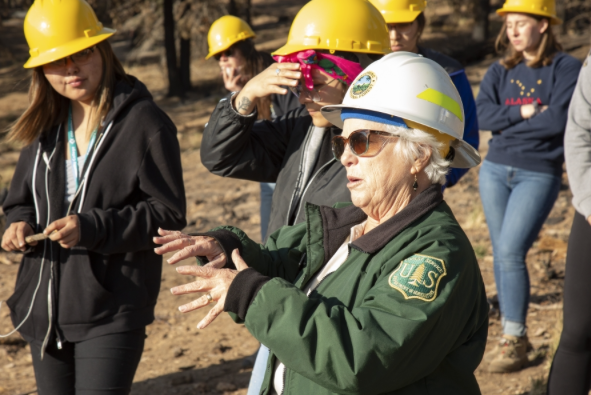
Coconino Community College students listen to U.S. Forest Service volunteer Karen Malis-Clark describe the effects on the landscape of the recent Museum fire near Flagstaff. Courtesy photo.
FLAGSTAFF — The Coconino Community College students strolled up the hill, a fine dust from their footfalls swirling in the breeze. Smoke from a nearby prescribed fire filled their lungs and cut the strength of the sun.
Student Aryn Begay described the fallen, burned trees as “skeletons laid out all over the landscape.”
Begay and other students in Environmental Biology recently took a field trip to the Museum fire burn scar just north of Flagstaff on the San Francisco Peaks to learn about fire’s role in the ecosystem. The fire, which happened this summer, burned nearly 2,000 acres of an area designed to protect the city’s watershed, called the Flagstaff Watershed Protection Project.
“Environmental Biology focuses on the interactions between living organisms and their environment,” said CCC science faculty Melinda McKinney, who organized the field trip. “We explore human impacts on ecological system form and function and seek solutions for a sustainable future.”
The students were led through the burn area by retired U.S. Forest Service employee Karen Malis-Clark, who now serves as a volunteer.
“All this is important because we choose to live in a fire-dependent ecosystem,” Malis-Clark said. “The more we understand the landscape and fire’s role in it, the better decisions can be made to protect the land and our community.”
McKinney said that she brought Malis-Clark into her classroom prior to the field trip to provide information on fire behavior to provide context for what the students were going to be seeing.
“There is nothing that compares to first-hand experience when it comes to enriching learning, and putting boots on the ground in the Museum fire burn scar was an amazing experience,” McKinney said. “The charred wood and ash juxtaposed with re-emerging grasses and patches of unburned areas create a surreal experience.”
Malis-Clark said that she hoped the students came away with a deeper knowledge of fire behavior, the complexity of forest management and the role fire plays in a healthy forest.
During the visit, Malis-Clark dropped water on soil that had been impacted by the fire. The students watched as the water, instead of absorbing, beaded on the surface, suggesting the potential for flooding. Much of the current work in the burn scar deals with minimizing the effects of future flooding, Malis-Clark said.
“I hope we each make an opportunity to visit those sites in a year, two years, five years, and compare with what we saw this week,” Malis-Clark said of the student experience.
Begay, who is studying Hotel and Restaurant Management at CCC, said she enjoyed the field trips.
“We’re learning a lot about the environment, and I get to learn new things every day,” Begay said.
While passing through the Museum fire scar, she noticed plants already growing in the burned area.
“Mother Nature is resilient,” she said. “That was unexpected.”
